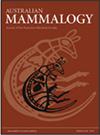Temporal effect of feeding on the body temperature and behaviour of captive koalas (Phascolarctos cinereus)
IF 1.2
4区 生物学
Q3 ZOOLOGY
引用次数: 3
Abstract
Free-ranging koalas generally feed at night; however, captive koalas are usually fed during the day in order to encourage activity for display purposes. We studied the temporal effect of feeding on body temperature of captive koalas in Queensland, to determine whether nocturnal feeding may be beneficial for koalas in warmer climates. Six adult koalas were implanted with thermal transmitters and data loggers, waxed together as a single package, to record internal body temperature. Koalas were exposed to two treatments: koalas were fed in the morning (between 0730 and 0830 hours) during the AM treatment or late afternoon (between 1700 and 1800 hours) for the PM treatment. The body temperature of koalas fed in the mornings was on average 0.5°C higher at its peak (P ≤ 0.01) when compared to koalas fed in the evening. Furthermore, the body temperature maxima of morning-fed koalas was reached ~2 h earlier in the afternoon, compared with those fed in the evening. There was no significant difference between behaviours associated with the two feeding regimes: inactivity (P = 0.840), feeding (P = 0.472) and activity (P = 0.634). We postulate that nocturnal feeding by koalas may be an adaptive mechanism that reduces diurnal heat load during times of high environmental temperatures.摄食对圈养无尾熊体温和行为的时间效应
自由放养的考拉一般在晚上进食;然而,圈养的考拉通常是在白天喂食,以鼓励它们活动,以示展示。我们研究了摄食对昆士兰州圈养考拉体温的时间影响,以确定夜间摄食是否对温暖气候下的考拉有益。6只成年考拉被植入了热变送器和数据记录器,它们被打包在一起,用来记录内部体温。考拉接受两种治疗:上午治疗期间,考拉在上午(07:30至08:30小时)喂食;下午晚些时候(1700至1800小时)喂食,进行PM治疗。早晨采食的无尾熊体温峰值比晚上采食的平均高0.5℃(P≤0.01)。此外,上午喂养的考拉在下午达到体温最大值比晚上喂养的考拉早2 h左右。不活动(P = 0.840)、进食(P = 0.472)和活动(P = 0.634)两种摄食方式的相关行为无显著差异。我们假设考拉夜间进食可能是一种适应机制,可以在高环境温度下减少白天的热负荷。
本文章由计算机程序翻译,如有差异,请以英文原文为准。
求助全文
约1分钟内获得全文
求助全文
来源期刊

Australian Mammalogy
ZOOLOGY-
CiteScore
2.50
自引率
8.30%
发文量
26
期刊介绍:
Australian Mammalogy is a major journal for the publication of research in all branches of mammalogy. The journal’s emphasis is on studies relating to Australasian mammals, both native and introduced, and includes marine mammals in the Antarctic region. Subject areas include, but are not limited to: anatomy, behaviour, developmental biology, ecology, evolution, genetics, molecular biology, parasites and diseases of mammals, physiology, reproductive biology, systematics and taxonomy.
Australian Mammalogy is for professional mammalogists, research scientists, resource managers, consulting ecologists, students and amateurs interested in any aspects of the biology and management of mammals.
Australian Mammalogy began publication in 1972 and is published on behalf of the Australian Mammal Society.
 求助内容:
求助内容: 应助结果提醒方式:
应助结果提醒方式:


